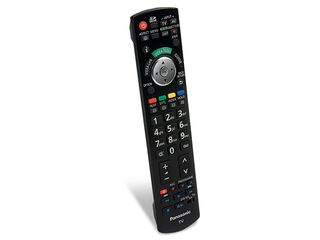TechRadar Verdict
Generally sound plasma with decent array of features for about the right price
Pros
- +
General performance
- +
Features
- +
Price
Cons
- -
Surprisingly glitchy movement
- -
Soft-ish detail
Why you can trust TechRadar
Panasonic's enduring faith in plasma has been rewarded by the premier spot in the gas hierarchy. The TX-50V10 is from the upper middle of the firm's impressive NeoPDP series and combines top-grade video specs with mass-market versatility.
The set is fairly brimming with gadgetry, with a 1080p display driven by the fourth generation of the company's consistently effective V-real Pro processing suite.
This time it's partnered with 600Hz technology that can splice interpolated frames into the original material as it is played back in order to smooth out motion.
It also boasts a set of 'widgets' enabling you to browse a limited range of websites.
NeoPDP power
Panasonic's operating system has been around in broadly the same manifestation for a while now and there's no immediate need to change. The main setup menus are clear and economical, with just enough scope to keep habitual knob-twiddlers happy, while the operating system for the digital tuner slots nicely into the wider scheme of things with an open, easily legible EPG.
You can also avail yourself of the separate, slightly snazzier Viera Tools section that looks after the other compatible kit you may have hooked up in order to turn your telly into a home entertainment hub.

The remote is standard issue for the company's top enders and is slender and well labelled, with large keys. It works nicely with the graphical interface, and we can't imagine anyone experiencing any anxiety when installing this set for the first time.
Picture
To go straight to the set's few flaws and many talents, colours are realistic and carefully nuanced with the kind of cinematic lustre that characterises celluloid, but is rarely replicated on liquid crystal. The palette is balanced, with no discernible bias towards either red or green, and varying degrees of brightness are rendered without the banding that can occasionally afflict gas screens.
Black levels – the perennial ace up plasma's sleeve – are highly satisfying. The slavering dog that menaces Harry at the Knight Bus stop in Harry Potter and the Prisoner of Azkaban, for example (usually little more than a collection of bristly highlights and glittering eyes) is picked out remarkably well against the dark hedge from which it emerges.
The picture is also clean, with little processing noise or random digital dross. The best results are, as you'd expect, with hi-def movies, but DVDs are scarcely less impressive, and effective upconverting enables the standard-def format to survive being blown up to 50in without loss of dignity.
The TV's talents just about run out with Freeview, but the results are still perfectly acceptable from a decent distance and are more than adequate for daily viewing.
The only real problem we can find with the picture is unusually clumsy motion handling. Plasma is normally reasonably adept with movement, and Panasonic's banging on about its 600Hz sub-field jiggery-pokery leads you to expect an entirely judder-free experience. But this is not entirely the case.

All of the material we threw at it, from Freeview shopping channels to hi-def movies, betrayed the same occasional jerkiness which, once noticed, was difficult to ignore. It's not cripplingly conspicuous, but the swirling helicopter pans over the Great Wall in the The Mummy 3, or over Hogwarts, are disappointingly wobbly on occasions.
Still, there's precious little else wrong with the picture. Unless, of course, you prefer the laser-like detail precision of LCD to plasma's slightly broader brush-strokes, but as we don't, necessarily, we won't mark it down too harshly on that score.
Audio is neither here nor there, really. The chassis has aspirations to wall-hung skinniness, so there's precious little room for any serious acoustic hardware and the noise the Panasonic produces is, rather predictably, adequate rather than awesome.
It's faithful enough and a match for broadcast material, but blockbusting movies expose a lack of real depth and bass. There is, however, an optical digital output on the back panel that enables you to divert the signal, in Dolby Digital form, to an external amp, or you could just wire your Blu-ray deck or digibox straight into your home cinema system for greater sonic satisfaction.
Nearly two grand isn't particularly cheap for a television, even one as large as this. But given its enormity, solid overall performance and generous array of features, we'd say the price is just about right.
Follow TechRadar Reviews on Twitter: http://twitter.com/techradarreview
The TechRadar hive mind. The Megazord. The Voltron. When our powers combine, we become 'TECHRADAR TEAM'. You'll usually see this author name when the entire team has collaborated on a project or an article, whether that's a run-down ranking of our favorite Marvel films, or a round-up of all the coolest things we've collectively seen at annual tech shows like CES and MWC. We are one.

Huge Nikon camera sale drops Z8, Z5, Z7 II, and more to record-low prices

6-screen laptop manufacturer is very much alive — Acme Portable's Megapac L3 is the original hexadisplay mobile powerstation and is still on sale, shame that it is still using old dual CPU tech from AMD and Intel

The Hisense U9N 4K TV is mini-LED taken to the max, with powerful built-in Dolby Atmos sound too – Samsung should be worried
